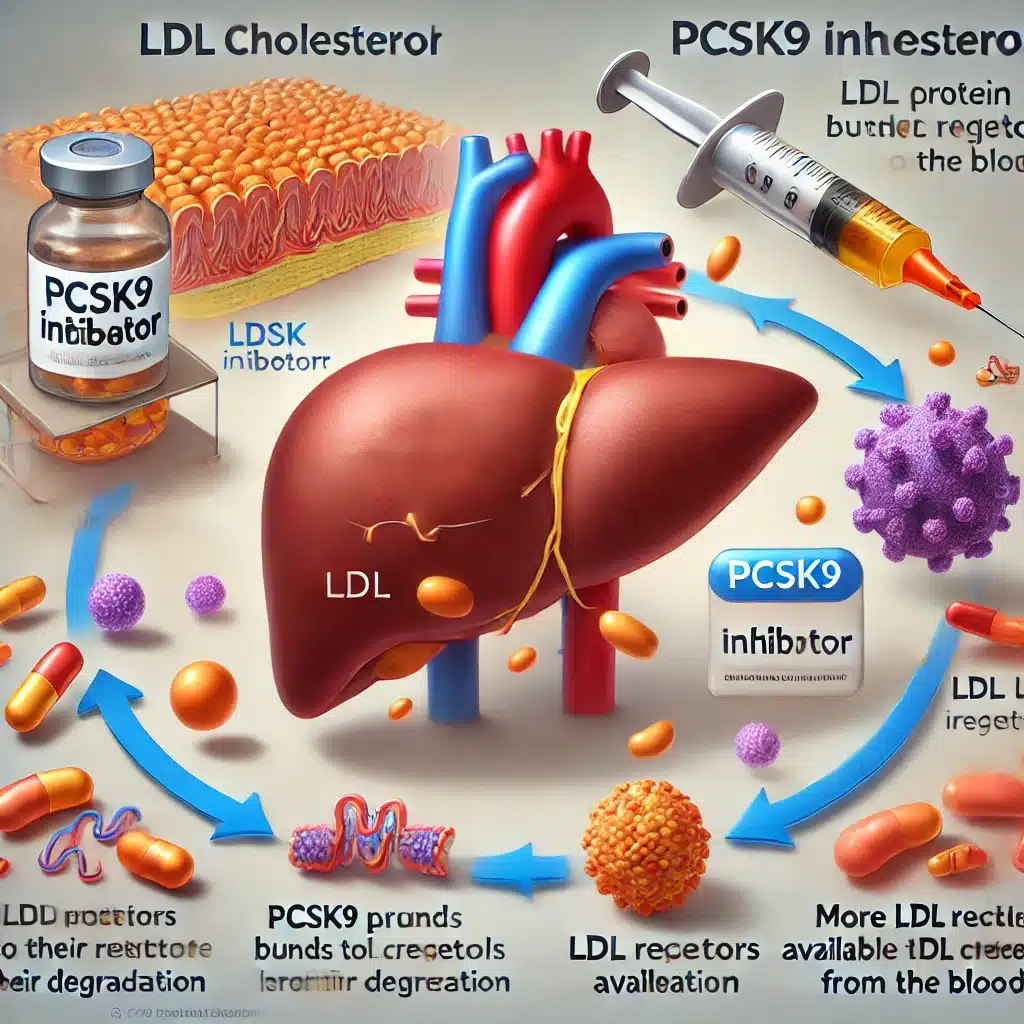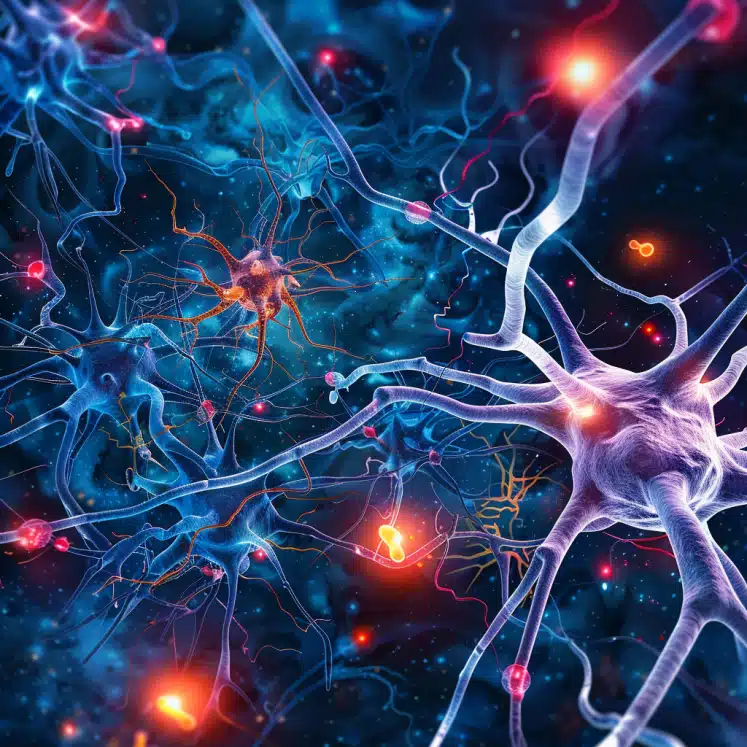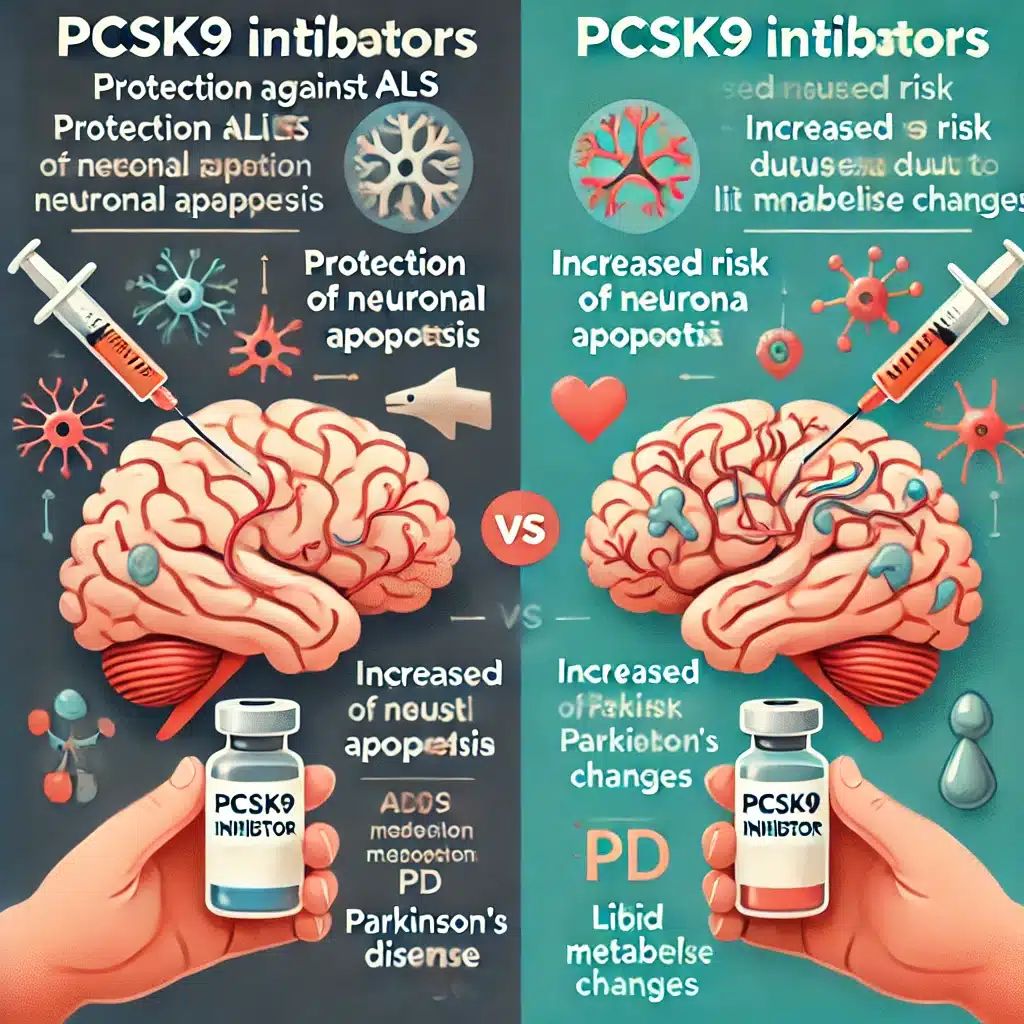PCSK9 inhibitors significantly reduce the risk of amyotrophic lateral sclerosis (ALS) but increase the risk of Parkinson’s disease (PD).
Highlights:
- ALS Risk Reduction: PCSK9 inhibitors marginally reduced the risk of ALS with an odds ratio of 0.89 (p = 0.048).
- PD Risk Increase: PCSK9 inhibitors increased the risk of Parkinson’s disease, with an odds ratio of 1.417 (p = 0.004).
- Statin Comparison: HMGCR inhibitors, such as statins, also increased the risk of Parkinson’s disease, with an odds ratio of 1.907 (p = 0.001).
- No Significant Effect on AD: Neither PCSK9 nor HMGCR inhibitors showed a significant association with Alzheimer’s disease risk.
- Methodology: The findings were based on drug-targeted Mendelian randomization analysis using SNPs associated with PCSK9 and HMGCR from genome-wide association studies.
Source: Brain & Behavior (2024)
Major Findings: PCSK9 Inhibitors & Risk of Neurodegenerative Diseases (2024 Analysis)
1. Reduction in ALS Risk by PCSK9 Inhibitors
PCSK9 inhibitors demonstrated a marginally significant protective effect against amyotrophic lateral sclerosis (ALS).
The odds ratio (OR) for developing ALS in individuals treated with PCSK9 inhibitors was 0.89 (95% CI: 0.77 to 1.00), with a p-value of 0.048.
This suggests that individuals using PCSK9 inhibitors have an 11% reduced risk of developing ALS compared to those not using these inhibitors.
ALS is a neurodegenerative disease characterized by the progressive loss of motor neurons, leading to severe physical disability and respiratory failure.
The protective effect observed may be due to the pleiotropic effects of PCSK9 inhibitors, which include mechanisms beyond lipid-lowering, such as interference with the anti-apoptotic signaling pathway via modulation of Apolipoprotein E Receptor 2 (ApoER2).
2. Increased Risk of Parkinson’s Disease with PCSK9 & HMGCR Inhibitors
PCSK9 inhibitors were found to significantly increase the risk of developing Parkinson’s disease (PD), with an OR of 1.417 (95% CI: 1.178 to 1.657) and a p-value of 0.004.
This indicates a 41.7% higher risk of PD in individuals using PCSK9 inhibitors. Similarly, HMGCR inhibitors, commonly known as statins, were also associated with an increased risk of PD.
The OR for PD with statin use was 1.907 (95% CI: 1.502 to 2.312), with a p-value of 0.001, reflecting a 90.7% increased risk.
PD is a neurodegenerative disorder marked by the degeneration of dopaminergic neurons in the substantia nigra, leading to motor and non-motor symptoms.
The association between lipid-lowering therapies and increased PD risk suggests a potential lipid-related mechanism influencing PD pathogenesis.
3. No Significant Association with Alzheimer’s Disease
Neither PCSK9 inhibitors nor HMGCR inhibitors showed a significant causal relationship with the risk of developing Alzheimer’s disease (AD).
The analysis did not find statistically significant ORs for AD, indicating that the use of these lipid-lowering therapies does not have a clear impact on the risk of AD.
AD is characterized by the accumulation of β-amyloid plaques and neurofibrillary tangles in the brain, leading to cognitive decline and dementia.
The lack of significant association in this study contrasts with some observational studies that suggested a potential protective role of statins in AD.
4. Mendelian Randomization Analysis for Causality
The study utilized drug-targeted Mendelian randomization (MR) analysis to explore the causal relationship between PCSK9 inhibitors, HMGCR inhibitors, and neurodegenerative diseases.
Single nucleotide polymorphisms (SNPs) associated with PCSK9 and HMGCR were selected from genome-wide association studies (GWAS) and used as instrumental variables.
The inverse variance weighted (IVW) method was the primary analytical approach, supported by MR Egger, weighted median, simple mode, weighted mode, and MR-PRESSO analyses to ensure robustness.
Sensitivity analyses, including leave-one-out and Steiger tests, were performed to validate the results and check for reverse causality and pleiotropy.
5. Reduced Risk of Coronary Heart Disease (CHD)
As a positive control, the study confirmed that both PCSK9 inhibitors and HMGCR inhibitors significantly reduced the risk of coronary heart disease (CHD).
The OR for CHD with PCSK9 inhibitors was 0.59 (95% CI: 0.46 to 0.72), with a p-value of 6.58 × 10^−15, while the OR for CHD with HMGCR inhibitors was 0.69 (95% CI: 0.55 to 0.84), with a p-value of 9.85 × 10^−7.
This validation step ensured that the instrumental variables used were appropriate for detecting causal effects.
6. European Population & Inferred Causality
The study acknowledges several limitations, including the restriction to a European population, which limits the generalizability of the findings to other ethnic groups.
Additionally, MR studies, while powerful for inferring causality, cannot replace clinical trials and real-world evidence.
The findings highlight the need for further research to elucidate the mechanisms by which PCSK9 and HMGCR inhibitors influence neurodegenerative diseases and to explore these effects in diverse populations through clinical trials.
7. Nuanced Effects of PCSK9 Inhibitors
The study’s findings reveal a nuanced role of lipid-lowering therapies in neurodegenerative diseases, with PCSK9 inhibitors providing a protective effect against ALS but increasing the risk of PD, while HMGCR inhibitors (statins) also heighten the risk of PD.
These insights underscore the importance of personalized medicine and the need for careful consideration of the broader biological effects of lipid-lowering drugs beyond their cardiovascular benefits.
How PCSK9 Inhibitors May Reduce ALS Risk (Possible Mechanisms)

1. Neuronal Apoptosis Regulation
PCSK9 & Apolipoprotein E Receptor 2 (ApoER2): PCSK9 influences neuronal apoptosis by modulating the ApoER2 pathway. This pathway is crucial in synaptic plasticity and neuronal survival.
Anti-apoptotic Signaling: By inhibiting PCSK9, these inhibitors may enhance anti-apoptotic signaling, reducing neuronal cell death and thereby lowering the risk of ALS.
2. Lipid Metabolism & Neuroprotection
Cholesterol Regulation: ALS has been linked to lipid metabolism disturbances. PCSK9 inhibitors lower low-density lipoprotein cholesterol (LDL-C) levels, potentially stabilizing lipid homeostasis in neurons and offering neuroprotective effects.
How PCSK9 Inhibitors May Increase Parkinson’s Disease Risk (Possible Mechanisms)
1. Serum Lipoprotein Levels & PD Risk
There is an established inverse relationship between serum lipoprotein levels and PD risk.
Lower lipoprotein levels, resulting from PCSK9 inhibition, may negatively impact neuronal health, thereby increasing PD risk.
2. Neuroinflammation & Oxidative Stress
PCSK9 inhibitors may inadvertently modulate inflammatory pathways.
Increased inflammation and oxidative stress are known contributors to PD pathogenesis, suggesting that PCSK9 inhibition might exacerbate these processes in the brain.
3. Neurotoxic Effects
While PCSK9 inhibition can be neuroprotective in some contexts, it might also activate or fail to inhibit certain apoptotic pathways in dopaminergic neurons, crucial in PD.
This paradoxical effect could explain the increased risk.
Lack of Significant Effect on Alzheimer’s Disease
Amyloid-beta (Aβ) and BACE1 Regulation
Conflicting Evidence: Studies have shown mixed results on how PCSK9 impacts Aβ and BACE1 levels, both of which are critical in AD pathogenesis. PCSK9 inhibition’s inconsistent effects on these molecules may explain the lack of significant findings in AD risk.
Cholesterol & AD Pathogenesis
Neutral Effects on AD: Despite cholesterol’s role in AD, PCSK9 inhibition does not appear to significantly alter AD risk, possibly due to compensatory mechanisms in cholesterol metabolism that maintain amyloid processing and deposition.
PCSK9 Inhibitors (Overview): Usage & Indications

Proprotein convertase subtilisin/kexin type 9 (PCSK9) inhibitors are a class of lipid-lowering drugs that target the PCSK9 protein.
By inhibiting PCSK9, these drugs enhance the liver’s ability to remove low-density lipoprotein cholesterol (LDL-C) from the blood, thereby significantly lowering LDL-C levels.
Medical Conditions Treated with PCSK9 Inhibitors
PCSK9 inhibitors are primarily used to treat conditions associated with high cholesterol levels, particularly those that are resistant to conventional therapies:
- Hypercholesterolemia: Including familial hypercholesterolemia, a genetic disorder characterized by extremely high cholesterol levels and increased risk of cardiovascular disease.
- Atherosclerotic Cardiovascular Disease (ASCVD): Used for secondary prevention in patients with established ASCVD who require additional LDL-C lowering despite maximally tolerated statin therapy.
Usage Frequency
- PCSK9 inhibitors are typically prescribed when patients do not achieve sufficient LDL-C reduction with statins and lifestyle changes alone. They are often used in conjunction with other lipid-lowering therapies.
- The frequency of administration is usually every two to four weeks, depending on the specific drug and patient response.
Common PCSK9 Inhibitors
Alirocumab (Praluent)
- Indications: Used for patients with primary hyperlipidemia (including heterozygous familial hypercholesterolemia) and for secondary prevention of cardiovascular events in patients with ASCVD.
- Dosage: Administered via subcutaneous injection every two to four weeks.
Evolocumab (Repatha)
- Indications: Similar to alirocumab, used for hyperlipidemia and secondary prevention in ASCVD, and for homozygous familial hypercholesterolemia.
- Dosage: Administered via subcutaneous injection every two to four weeks.
Efficacy & Benefits
PCSK9 inhibitors can reduce LDL-C levels by up to 60% when used in combination with statins.
They have been shown to decrease the incidence of major cardiovascular events, such as heart attack and stroke, particularly in high-risk populations.
Safety & Side Effects
Generally well-tolerated with a safety profile similar to other biologic agents.
Common side effects include injection site reactions, nasopharyngitis, and flu-like symptoms.
Long-term safety data are still being accumulated, but current evidence supports their use as effective and safe for managing high cholesterol and reducing cardiovascular risk.
PCSK9 Inhibitors vs. Risk of Neurodegenerative Diseases (2024 Mendelian Randomization)

The study aimed to investigate the causal effects of PCSK9 inhibitors on the risk of various neurodegenerative diseases, including amyotrophic lateral sclerosis (ALS), Parkinson’s disease (PD), and Alzheimer’s disease (AD), using drug-targeted Mendelian randomization (MR) analysis. Additionally, the study compared these effects with those of HMGCR inhibitors (statins).
Sample
- Data was collected from genome-wide association studies (GWAS) involving European populations.
- Summary statistics were obtained for 440,546 individuals regarding LDL-C levels and genetic variations in PCSK9 and HMGCR.
- Neurodegenerative disease data included 42,096 coronary heart disease (CHD) cases, 99,121 controls, and specific datasets for ALS, PD, and AD.
Methods
- Instrumental Variables: Selected single nucleotide polymorphisms (SNPs) within ±100 kb of the PCSK9 or HMGCR loci associated with LDL-C levels.
- Analytical Techniques: Utilized inverse variance weighted (IVW) as the primary method, supplemented by MR Egger, weighted median, simple mode, weighted mode, and MR-PRESSO for robustness.
- Sensitivity Analyses: Employed Cochrane’s Q, MR Egger regression, leave-one-out method, and Steiger analysis to assess heterogeneity, pleiotropy, and reverse causality.
Limitations
- Population Restriction: The study was limited to European populations, reducing generalizability to other ethnic groups.
- Data Constraints: Relied on GWAS summary statistics, lacking external data validation.
- Study Design: MR studies infer causality but cannot replace clinical trials or real-world evidence.
Causality vs. Correlation in the Findings of PCSK9 Inhibitors and Neurodegenerative Diseases
The study utilized drug-targeted Mendelian randomization (MR) to infer causal relationships between PCSK9 inhibitors and the risk of neurodegenerative diseases such as ALS, PD, and AD.
MR is a robust method that leverages genetic variations as instrumental variables to mimic the effects of a drug, thus minimizing confounding and reverse causation.
However, several factors must be considered to evaluate the confidence in causality.
Genetic Interactions & Pleiotropy
Pleiotropy: Genetic variants used as instruments in MR studies can have pleiotropic effects, influencing multiple traits through different biological pathways. The study used multiple analytical methods (MR Egger, weighted median, etc.) to detect and adjust for horizontal pleiotropy, ensuring that the observed associations are not confounded by these effects.
Genetic Interactions: Complex interactions between different genetic variants across the genome can impact the results. While MR studies provide strong evidence for causality, they may not fully capture the intricate genetic network that influences disease risk.
Selection of SNPs
Instrumental Variables: The study selected SNPs within ±100 kb of the PCSK9 and HMGCR loci associated with LDL-C levels. The choice of these specific SNPs, and their relevance to the biological pathways of neurodegenerative diseases, enhances the confidence in the causal inference.
Whole Genome Coverage: The analysis focused on specific loci rather than the entire genome. While this targeted approach increases precision, it might overlook other relevant genetic factors that contribute to disease risk.
Consistency Across Methods
Robustness of Results: The use of various MR methods (IVW, MR Egger, weighted median) to cross-validate the findings strengthens the confidence in the causal relationships. Consistent results across these methods indicate that the associations are less likely to be due to chance or confounding factors.
Positive Control: The study’s use of coronary heart disease (CHD) as a positive control confirmed the expected effects of PCSK9 and HMGCR inhibitors, validating the instrumental variables used and supporting the reliability of the findings for neurodegenerative diseases.
Limitations & Potential Biases
Population Restriction: The study was conducted using data from European populations, which may limit the generalizability of the findings to other ethnic groups. Genetic diversity across populations can influence the applicability of the results.
GWAS Summary Statistics: The reliance on summary-level data from GWAS may introduce biases related to data aggregation and the specific methodologies of the original studies. Additionally, the lack of external data validation could affect the robustness of the conclusions.
Potential for Correlation
Residual Confounding: Despite the strengths of MR, there is always a possibility of residual confounding from unmeasured variables. Although MR minimizes this risk compared to observational studies, it cannot entirely eliminate it.
Correlation vs. Causation: While MR provides strong evidence for causality, the results should be interpreted with caution. The associations observed might still reflect underlying correlations influenced by complex genetic and environmental interactions not fully accounted for in the study.
Conclusion: PCSK9 Inhibitors vs. ALS & Parkinson’s Disease RIsk
The study provides compelling evidence that PCSK9 inhibitors significantly reduce the risk of amyotrophic lateral sclerosis (ALS) while increasing the risk of Parkinson’s disease (PD).
Utilizing drug-targeted Mendelian randomization (MR) analysis, the research highlights a potential causal relationship by leveraging genetic variations associated with PCSK9 and HMGCR loci.
Despite the robustness of MR, the findings should be interpreted cautiously due to limitations such as the focus on European populations and the reliance on GWAS summary statistics.
The lack of a significant effect on Alzheimer’s disease (AD) underscores the complexity of lipid-lowering therapies’ impact on neurodegenerative diseases.
Further research, particularly in diverse populations and incorporating broader genetic interactions, is necessary to validate these results and elucidate the precise mechanisms at play.
These findings contribute to the growing understanding of the multifaceted roles of lipid-lowering drugs beyond cardiovascular benefits, emphasizing the need for personalized medicine in managing neurodegenerative disease risks.
References
- Study: Causal relationship between PCSK9 inhibitor and common neurodegenerative diseases: A drug target Mendelian randomization study (2024)
- Authors: Qiang Huang et al.







